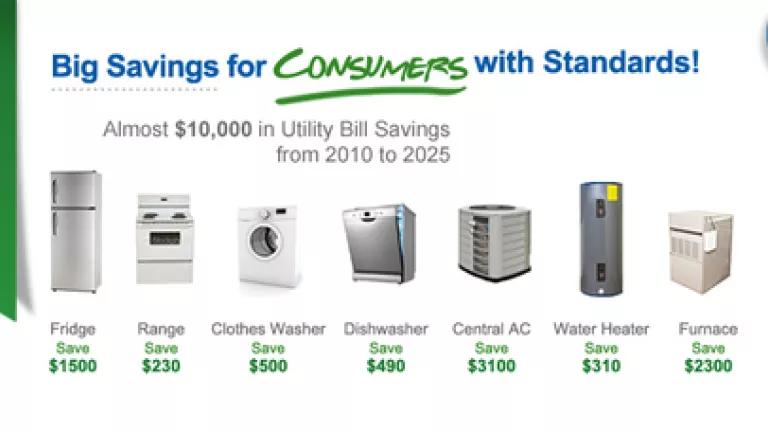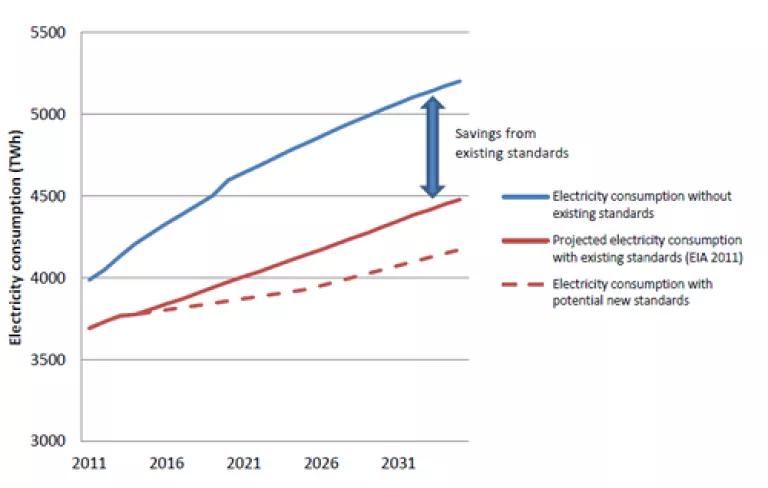The Mega Trillion Dollar Jackpot: Appliance Efficiency Standards Have Saved Consumers Big Bucks, And Even Bigger Savings are on the Way

Not one of lucky three winners of last weekend’s Mega-Millions $640 million jackpot? Me neither. But thankfully for us all, appliance standards have been quietly saving big dollars for consumers for the past 3 decades and more are on the way – no luck involved.
Existing appliance efficiency standards will have saved consumers a net $1.1 trillion cumulatively by 2035, a recent report by the Appliance Standards Awareness Project (ASAP) and the American Council for an Energy Efficient Economy (ACEEE) find, and even greater savings are possible from upcoming standards over the next 4 years, such as those for clothes washers and dishwashers, which are currently pending at the Office of Management and Budget. The report uses an illustrative example to show that an average homeowner replacing their appliances every 15 years will save a total of $30,900 on utility bills between 1995 and 2040 because of standards, equivalent to the amount spent on 2 years of mortgage payments for the average US household. The picture below illustrates a subset of this example: how much a consumer could save by product between 2010 and 2025. While it’s not quite as much as hitting the Mega Millions jackpot, it is real money in consumers’ pockets and you can’t beat the odds.
Source: ASAP
The report, The Efficiency Boom: Cashing in on the Savings from Appliance, analyzes the consumer, energy and emissions savings from existing energy efficiency standards for appliances and equipment as well as the potential benefits of new or updated standards for 34 products that are likely to be finalized between now and 2015. Congress first enacted efficiency standards in the 1980s, and tasked the Department of Energy with updating these and setting new standards as appropriate for a variety of residential appliances, commercial and industrial products, and lighting. Products that meet DOE standards still provide the same, or better, services to consumers, but use less energy doing so. During the 1990s and early 2000s, DOE fell behind on its statutory schedule for setting new standards, which resulted in a set of court-ordered and statutory deadlines which the current DOE has had to comply with. Because of these deadlines, DOE has issued new or updated standards for 17 products since January 2009, and another 11 are expected by January 2013.
Existing standards have reduced electricity use in the US significantly, in 2010 US electricity use was 7 percent lower due to existing standards, the report finds, and this number will grow to 14 percent by 2035, largely due to standards set in the past 3 years, as shown in the graph below. Peak electricity – the amount used on hot summer afternoons and other high demand times – will be reduced by 240 GW in 2035. How big is 240 GW? It is about twice the capacity of all the nuclear power plants in America combined. Peak demand is particularly important as it means fewer black outs and less need for costly peak power generation. The report also finds that annual natural gas savings from existing standards will be 950 TBtu in 2035, roughly enough to heat a third of all gas heated homes in the US.

Source: ACEEE & ASAP
These savings numbers could be even higher with potential new and updated standards on the way over the next few years. The report evaluated the savings from standards for 34 products, which they estimate could reduce projected electricity use an additional 7 percent by 2035. Some of the products with large potential savings include clothes washers, computers, set top boxes, water heaters, pumps, commercial refrigeration equipment, incandescent reflector lamps, metal halide lamps, and several more. Of this list, clothes washers, metal halide lamps, and commercial refrigeration equipment all are currently in final rule form awaiting OMB’s approval. The clothes washers rule in particular offers substantial savings for consumers – the ASAP report estimates a net present value of almost $16 billion dollars for consumer purchases of clothes washers through 2035 that meet the standards levels agreed to by manufacturers, consumer advocates and efficiency and environmental groups. New washers meeting these standards will use up to 35 percent less energy and 40 percent less water. Additionally these more efficient clothes washers wash clothes just as well --- all of the 10 top-rated washers from the 2012 Consumer Reports Buyer’s Guide already meet the proposed standard, scoring “excellent” and “very good” for washing performance.
The large energy and consumers savings benefits from existing and potential standards mentioned above also mean large environmental benefits. The report finds that together existing and potential standards together will reduce CO2 emissions in 2035 by close to 670 million metric tons, equivalent to the emissions of 167 coal-fired power plants. The report also finds that existing and potential standards would decrease NOx emissions by about 500 thousand metric tons and SOx emissions by about 750 thousand metric tons annually by 2035.
All in all, the report finds that existing appliance standards have greatly benefited consumers and the environment and that more savings are still on the way. OMB and DOE should continue to move forward on pending standards, such as for clothes washers, that offer significant environmental and consumer benefits. You can still buy that Mega Millions ticket but odds are high that you’ll get more cash back from appliance standards.